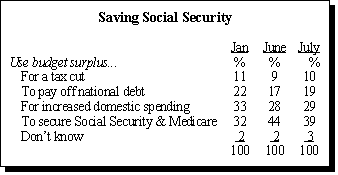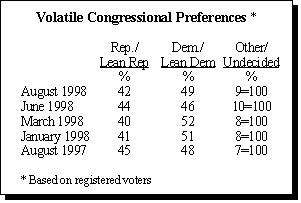Introduction and Summary
As Congress heads home for the summer campaign season, both parties face tough sells for their election themes. Despite Democratic charges of a Republican-led do-nothing Congress, Americans see the 105th Congress as no different than others in recent memory. But the GOP will have to shore up its image on issues, as the public lines up with Democrats on the issue of health care reform.
The dominant perception of this Congress is that it has been more rancorous than usual: 51% of the public says members have been bickering and opposing one another more than usual. Asked about Congress’ productivity, only 15% of Americans say that it has accomplished less than most — 18% think it has accomplished more. Even among those who disapprove of the Republican leadership, 55% think that this Congress has been as active as previous ones.
These are the principal findings of a Pew Research Center telephone survey of 1,189 adults, conducted July 29-August 2, 1998. The survey has a margin of error of +/- 3.5%.
Public Wants Action on HMOs
Americans’ perception of an active Congress may reflect public support for several proposals to regulate health maintenance organizations (HMOs) and expand patient rights. Early this summer, the public ranked HMO regulation as very important to them personally and for the country.1 This month, even when presented with arguments against new restrictions, most Americans back federal involvement.
Fully 53% of Americans support the creation of national standards for patients in HMOs and managed care plans; only 35% say that such regulation would “get the government too involved in health care.” Similarly, 53% of the public supports changing the law to allow patients to sue insurance companies that deny or delay medical benefits. Only 35% say that such changes would “increase the costs of insurance too much.”
 Not surprisingly, the Democratic rank and file support both proposals: 65% favor national standards and 57% favor granting patients the right to sue their insurance companies.
Not surprisingly, the Democratic rank and file support both proposals: 65% favor national standards and 57% favor granting patients the right to sue their insurance companies.
Republicans are divided in their attitudes toward national standards (42% support vs. 44% oppose). A plurality favors legislation to allow lawsuits (46% vs. 40% oppose). Majorities of Independents support both proposals.
Americans’ preference for government regulation of managed care aligns them with the Democratic Party on this issue. A plurality of the public (39%) expresses more confidence in congressional Democrats “to do the right thing regarding the regulation of HMOs”; only 29% say the same of the Republicans on the Hill. The remainder are undecided.
A Back Seat for a Tax Cut
 In another top issue on the congressional agenda — the allocation of a potential budget surplus — the public supports President Clinton’s call to use a surplus to stabilize Social Security and Medicare. A clear plurality (39%) choose this option over increased spending on domestic programs (29%), paying off the national debt (19%) or providing a tax cut (10%).
In another top issue on the congressional agenda — the allocation of a potential budget surplus — the public supports President Clinton’s call to use a surplus to stabilize Social Security and Medicare. A clear plurality (39%) choose this option over increased spending on domestic programs (29%), paying off the national debt (19%) or providing a tax cut (10%).
When the choice is simply between a tax cut and making the Social Security system financially sound, Americans overwhelmingly opt for shoring up the retirement program by a margin of more than three-to-one: 76% favor focusing on Social Security; 22% favor a tax cut. Even a 68% majority of Republicans prefer dealing with these entitlements over cutting taxes.
Like their elder counterparts, Generation Xers choose spending over taxes by a wide margin (65% vs. 33%, respectively). However, those between the ages of 18 and 29 are the least supportive of any age group. When given the option, they overwhelmingly select increased spending on domestic programs over stabilizing Social Security (48% vs. 19%, respectively).
Congressional Horse Race
 Partisan preferences in congressional voting intentions have fluctuated throughout the year, with the two parties in a statistical dead heat as recently as June. Today, Democrats hold a 49%-to-42% advantage over Republicans among registered voters. The unsettled opinion on this question may reflect a lack of conviction and engagement. Just 13% of the public reports paying very close attention to news about the campaign.
Partisan preferences in congressional voting intentions have fluctuated throughout the year, with the two parties in a statistical dead heat as recently as June. Today, Democrats hold a 49%-to-42% advantage over Republicans among registered voters. The unsettled opinion on this question may reflect a lack of conviction and engagement. Just 13% of the public reports paying very close attention to news about the campaign.
Previous Pew Research Center surveys have shown greater indications of Republican strength. There is stronger support for incumbents this year than four years ago and an expected lower-than-usual turnout may also help GOP chances.2


